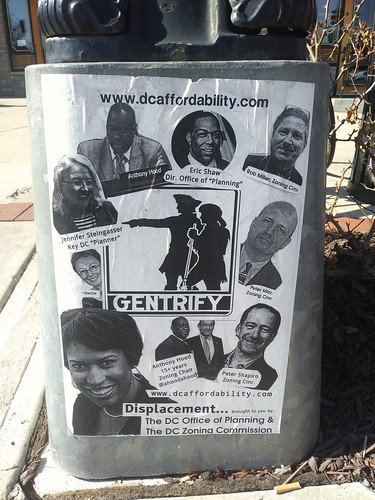Mayor Bowser Celebrates 700,000 District Residents (press release reprint)
From email:
Mayor Bowser Celebrates Population Milestone with Two of Washington, DC’s Newest Residents
(WASHINGTON, DC) – Mayor Bowser today celebrated that Washington, DC is now home to at least 700,000 residents. In December, the Bowser Administration announced that, according to new U.S. Census Bureau estimates, Washington, DC was quickly approaching 700,000 residents. Based on calculations by the DC Office of Planning’s State Data Center, it was predicted that the District would hit 700,000 residents in February 2018.
“Fifteen years ago, with the District’s population still on the decline, Mayor Williams set a goal of attracting 100,000 new residents within a decade. Since then, our population has grown by more than 130,000 residents,” said Mayor Bowser. “We are growing because we are a safer, stronger city, full of opportunity. As we continue to grow, my Administration remains focused on preserving our history and culture, ensuring we remain diverse and inclusive, and giving more Washingtonians the opportunity to participate in our city’s prosperity.”
As of July 1, 2017, Census data estimated Washington, DC’s population to be 693,972. With a growth rate of 1.4 percent between July 1, 2016 and July 1, 2017, the District ranks eighth in percent growth among the states.
Mayor Bowser celebrated the milestone at MedStar Washington Hospital Center with two families of newborn Washingtonians. Each family was presented with a gift basket of books and District-themed baby clothes and accessories, and each newborn received a full, four-year University of the District of Columbia Partnership (DC-UP) scholarship. The gifts were provided by the many DC Government agencies that have worked together over the last decade to make Washington, DC a safer, stronger, and more livable city for residents of all ages.
==========
This is a big deal.
When Mayor Williams set a goal in 2003 of 100,000 new residents, when the city had about 580,000 population (down from a peak of about 900,000 during the period of World War II, while the official population high was about 802,000 in 1950), it was seen very much as a stretch goal.
I wrote about the Mayor's goal in a then important local political e-letter called DC Watch ("Reprint from 2003: The Mayor's Campaign for 100,000 New Residents").
I was very much influenced by books like Get Urban by Kyle Ezell and the work of University of Pennsylvania planning professor Eugenie Birch ("Who Lives Downtown") and others. And "Shrinking city" planning efforts in cities like Youngstown, Ohio and Niagara Falls, New York. And my memories of living in a declining Detroit and the rise of the suburbs.
 Today, interestingly, the DC Grassroots Coalition for Planning sees adding population as a zero sum game, with the presumption that adding population by definition comes at the expense of those of lesser means, diminishes neighborhoods, etc.
Today, interestingly, the DC Grassroots Coalition for Planning sees adding population as a zero sum game, with the presumption that adding population by definition comes at the expense of those of lesser means, diminishes neighborhoods, etc.One of their complaints is the planning for achieving a greater population, of one million being touted in the current comprehensive planning process. (Note that this number was expected to be achieved in 1980, according to the city's 1950 comprehensive plan.)
I intend to write about that in terms of the arguments of "The Right to the City."
-- "Who Owns the 'Right to the City'? Moving Towards Urban Inclusivity," Yale F&ES Blog>
-- "David Harvey: The Right to the City," New Left Review 53, September-October 2008
-- "Do We Have a Right to the City?," Jacobin Magazine
Is the right to the city only possessed by those who already live in it?
Is only capital afforded the right to shape the city? Obviously not, as pointed out by Foglesong in Planning the Capitalist City (Prezi precis; intro).
But as pointed out in Growth Machine and Urban Regime theories ("A superb lesson in DC "growth machine" politics from Loose Lips (Washington City Paper)," 2006), capital is the most motivated of actors.
I think back to what the city was like in September 1987 when I first moved here, and I prefer to live in a community that is growing. Even if I believe that the planning and governance functions could be a lot better, there is no question that the added population supports a better and wider range of amenities, public safety, etc., which contribute to improved communities.
There is change, definitely, and not all of it is satisfactory.
But it's way way better than the shrinking city that was the case before Anthony Williams became elected.
DC Population (rounded)
| Year | Population |
|---|---|
| 1960 | 765,000 |
| 1970 | 757,000 |
| 1980 | 638,000 |
| 1990 | 605,000 |
| 2000 | 572,000 |
| 2010 | 604,000 |
Labels: demographics, urban design/placemaking, urban revitalization



2 Comments:
Video of today's event. Looks like baby Leah and Kooper even got a license plate!
https://twitter.com/MayorBowser/status/967157383775563777
LOL!
Post a Comment
<< Home